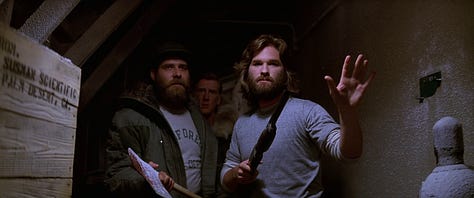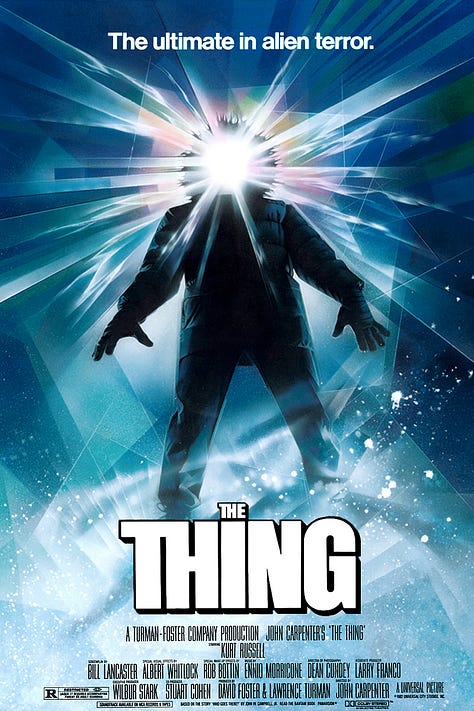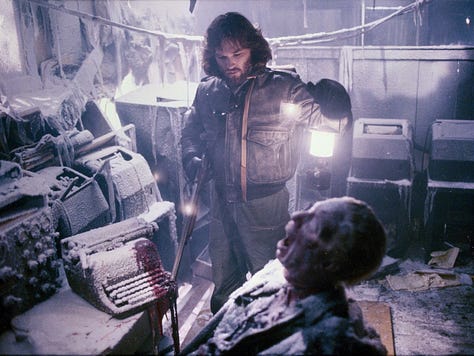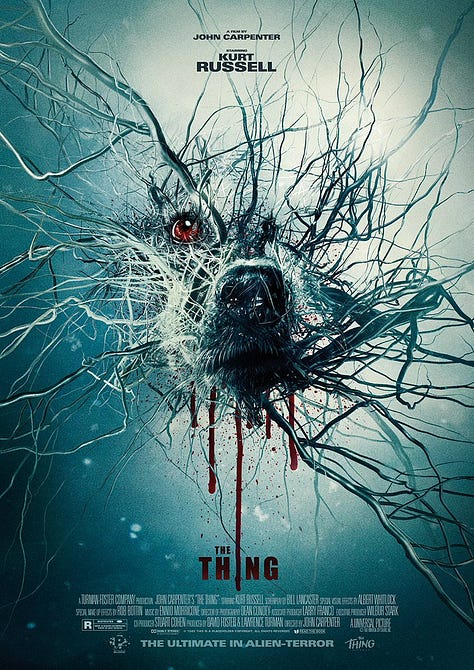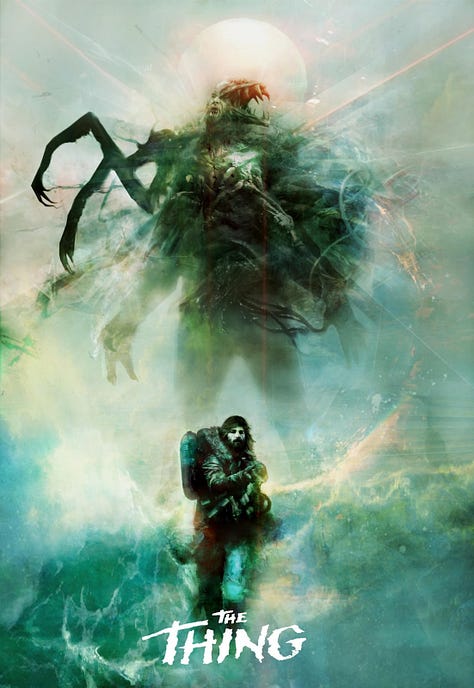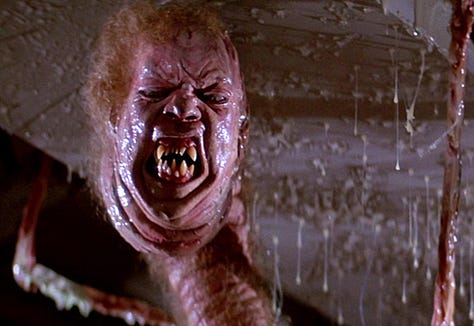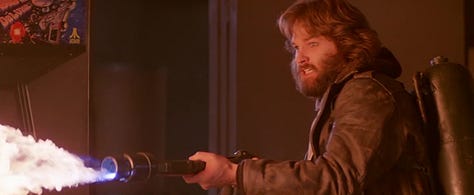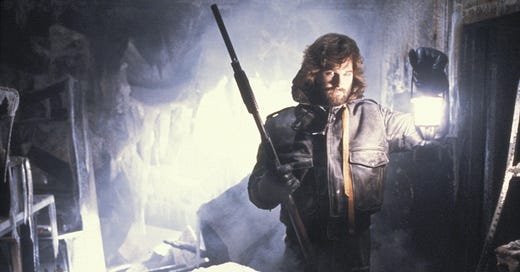THE THING
1982 • John CarpenterScreenplay: Bill Lancaster; Based on Who Goes There? by John W. Campbell
Cast: Kurt Russell, Wilford Brimley, T. K. Carter, David Clennon, Keith David, Richard Dysart, Charles Hallahan, Peter Maloney, Richard Masur, Joel Polis, Donald Moffat, Thomas Waites
Cinematography: Dean Cundey
Music: Ennio Morricone
Producers: David Foster, Lawrence Turman
Universal Pictures
I dunno what the hell's in there, but it's weird and pissed off, whatever it is.
A remote research facility in Antarctica becomes ground zero for unimaginable terror when a shape-shifting extraterrestrial organism infiltrates the base. As paranoia spreads among the crew, they realize that anyone could be the alien “Thing,” leading to a claustrophobic atmosphere of distrust and fear. The Thing infiltrates the crew, leading to a tense and terrifying battle for survival where no one can be trusted. In this frozen hellscape, the fight against the alien entity becomes a battle not only for their lives but for the very essence of humanity itself. Wall-to-wall fear permeates every frame of this film, leaving no moment untouched by unease.
“Wall-to-wall fear.” It's not a description that fits many films, but it perfectly encapsulates John Carpenter's 1982 sci-fi horror masterpiece, The Thing. From the first frame to the last, this film doesn't just make you uneasy; it burrows deep under your skin, creating a lingering sense of dread that continues to haunt your thoughts long after the credits roll. What makes this film a true exercise in the profoundly disturbing is its ability to delve into the darkest corners of human fear. It's not just a monster movie; it's psychological dread that preys on our deepest anxieties, exploiting our fears of isolation, betrayal, and the unknown.
Carpenter's genius lies in his ability to transform the icy desolation of Antarctica into a suffocating atmosphere of paranoia and terror. The idea of having people trapped in a frozen wasteland, stalked by an otherworldly horror, is played out with perfect precision. The chilling winds and endless snowdrifts mirror the isolation and hopelessness felt by the characters. When combined with Ennio Morricone's haunting score, the film's setting becomes as important as the characters themselves.
The Thing is a loose remake of the 1951 film The Thing from Another World, and both films were adapted from the 1938 novella Who Goes There? While the original film was fun in its own right, Carpenter's version took the concept to new and terrifying heights, or perhaps, depths. The 1982 adaptation managed to capture the essence of paranoia and mistrust far better than its predecessor. The alien in this version is not a lumbering humanoid creature but a shape-shifting entity capable of mimicking any life form it touches. This transformation intensifies the "who can you trust" atmosphere to blood-curdling levels. It blurs the line between friend and foe, leaving the characters (and the audience) in a perpetual state of uncertainty.
The film's special effects are a testament to practical effects mastery. In an era devoid of CGI, the visual effects team created grotesque and intense realistic effects that set the standard for horror movies for years. The transformation scenes are particularly memorable, showcasing the horrifying (and sickening) potential of the Thing's abilities. These effects, coupled with Carpenter's expert direction, make every encounter with the Thing a heart-stopping experience. The visceral impact of these scenes attacks your very psyche, leaving you peaking from behind your fingers in anticipation of what twisted monstrosity you’ll see next. And when you do see it, much like the character Palmer (David Clennon), you’ll also be saying in exasperated desperation “You’ve gotta be fucking kidding.”
Kurt Russell, in his role as R.J. MacReady, personified the jaded action hero of the 80s. His portrayal adds a layer of rugged determination to the film, a beacon of strength in the face of unimaginable horror. It’s amusing to think that only a decade earlier, Russell was a smiling and charming pretty boy in the live-action Disney films of the 60s and 70s. The Computer Wore Tennis Shoes this is not. The supporting cast, including Wilford Brimley, Keith David, and Donald Moffat, delivers realistic and relatable performances. The characters' reactions to the unfolding nightmare are genuine, and most of all, not stupid and tropey. Once they realize what is happening they, try to destroy it, but their paranoia gets the better of them.
The film explores claustrophobia and isolation expertly. Trapped in a research station at the literal ends of the Earth, with an alien entity that could be anyone or anything, the characters' fear becomes palpable. Every creaking sound, every flickering light, and every subtle glance between the crew members heighten the tension. The feeling of isolation and despair sits with you, mirroring the emotions of the characters on screen. Carpenter's directorial prowess ensures that the audience shares the same suffocating sense of confinement as the crew, making the viewing experience intensely immersive.
One of the most iconic and heart-stopping moments in the film occurs during a blood testing scene, a masterclass in suspense and surprise. As tensions reach a fever pitch among the remaining crew members at the Antarctic research station, R.J. MacReady devises a plan to determine who among them might be the shape-shifting alien creature. Using a heated wire to test blood samples, he attempts to expose the Thing. The scene begins with an eerie silence, MacReady's steady hands, holding a heated wire, move towards a petri dish containing a blood sample. As the wire pierces each sample, there's a brief moment of relief — your heart stops as it waits for what is sure to be a terrifying spectacle when the alien reveals itself. Whether you’ve seen the movie before, or its your first time, you are anticipating, much like the characters, the reveal in a cold sweat. You know it’s coming. And yet it STILL gets you. The explosiveness of the transformation, coupled with the stark contrast between the calm buildup and the revelation, creates a jump scare that will immediately trigger your fight or flight.
As much as The Thing is celebrated for its horrifying creature effects, it is also a testament to Carpenter's unique directorial style. His deliberate pacing and masterful use of tension build an atmosphere of dread that few films can match. The film's realistic dialogue enhances the sense of authenticity, making the characters' interactions feel genuine and unscripted. Carpenter's keen eye for detail is evident in every frame, elevating the film beyond mere horror and into the realm of cinematic artistry.
The film's impact on the horror genre is immeasurable. It laid the groundwork for future creature features, setting a high bar for practical effects and storytelling. The idea of an otherworldly horror lurking in the shadows, capable of assuming any form, is a terrifying one, ripe with possibilities that Carpenter takes full advantage of. The Thing is more than a movie; it's a thesis in fear, a symphony of terror that resonates across generations. It outclasses the sometimes cheesy nature of 1980s horror films and will frighten even the most jaded modern cinephile.
In the realm of sci-fi horror, The Thing stands shoulder to shoulder with Ridley Scott's Alien as one of the best the subgenre has to offer. Both films share a common thread of isolation and the fear of the unknown, but The Thing takes it a step further. It delves into the very core of human paranoia, exposing our vulnerability in the face of an incomprehensible threat. In The Thing, the desolate Antarctic setting amplifies the feeling of isolation and helplessness. The fear stems not just from the monstrous shape-shifting alien but from the uncertainty among the characters, trapped in close quarters with a potential imposter. Paranoia seeps through every interaction, leading to a palpable atmosphere of distrust and dread. John Carpenter's direction immerses the audience in a world where anyone could be the enemy, making the fear deeply personal and visceral.
Similarly, in Ridley Scott's Alien, the Nostromo spaceship becomes a claustrophobic nightmare. The tight, dimly lit corridors and the vastness of space outside create a sense of entrapment. As the crew members are stalked by a relentless extraterrestrial creature, paranoia takes hold. The fear of the unknown, coupled with the confined space, intensifies the terror. Scott expertly exploits this fear, making the audience acutely aware of the limited escape routes, enhancing the feeling of being trapped alongside the characters. Both films skillfully manipulate these elements, drawing viewers into worlds where fear and paranoia are not just emotions but tangible, suffocating entities, leaving a lasting impression on the psyche of anyone who dares to enter their chilling narratives.
Upon its initial release in 1982, The Thing faced a cold reception from both critics and audiences. Its unrelenting horror and groundbreaking special effects were ahead of their time, unsettling viewers in ways previously unseen. The film's graphic and realistic practical effects, which should have warranted Oscars for both effects and makeup, were largely overlooked by mainstream award committees. Instead, The Thing was even nominated for Razzie Awards, highlighting the absurdity of those dubious “awards.” However, as the years passed, the film gained a cult following, finding its audience in those who appreciated its audacious approach to horror. Its influence on the genre became undeniable, and its innovative use of practical effects set new standards for the industry. Over time, The Thing underwent a reevaluation, transforming from a rejected gem into a revered classic.
The 2011 prequel, also named The Thing, aimed to explore the harrowing events that transpired with the Norwegian research team before the events of the 1982 film. However, despite its potential, the prequel fell short of expectations. One of its most glaring shortcomings was the decision to replace the practical effects the crew already worked on with CGI, losing the visceral and tangible horror that made the 1982 version so impactful. The reliance on computer-generated imagery diminished the film's authenticity and failed to capture the raw, unsettling nature of its predecessor. Additionally, the prequel struggled to capture the same level of tension, fear, and paranoia that defined the original film. The film does have its defenders, but the attempt to expand the lore ultimately lacked the depth and intensity that made the original a classic.
The Thing famously ends ambiguously. After a thrilling climax, Carpenter expertly leaves some doubt as to who among the survivors is truly human. As the screen fades to black, accompanied by Ennio Morricone's unsettling score, the paranoia lingers. And as the credits roll, you find yourself questioning reality, haunted by the chilling possibility that, somewhere out there, the Thing might still be waiting.
Why don't we just wait here for a little while, see what happens.
Notoable Awards & Accomplishments
Empire Magazine 500 Greatest Movies of All Time - #289
Rolling Stone Best Horror Movies of All Time - #1
IMDB Top 250 - #152 (as of this writing)
Streaming: Peacock, AMC+
Digital Rental/Purchase: Available at most digital retailers
Physical Media: Available on 4K, Blu-Ray and DVD.

